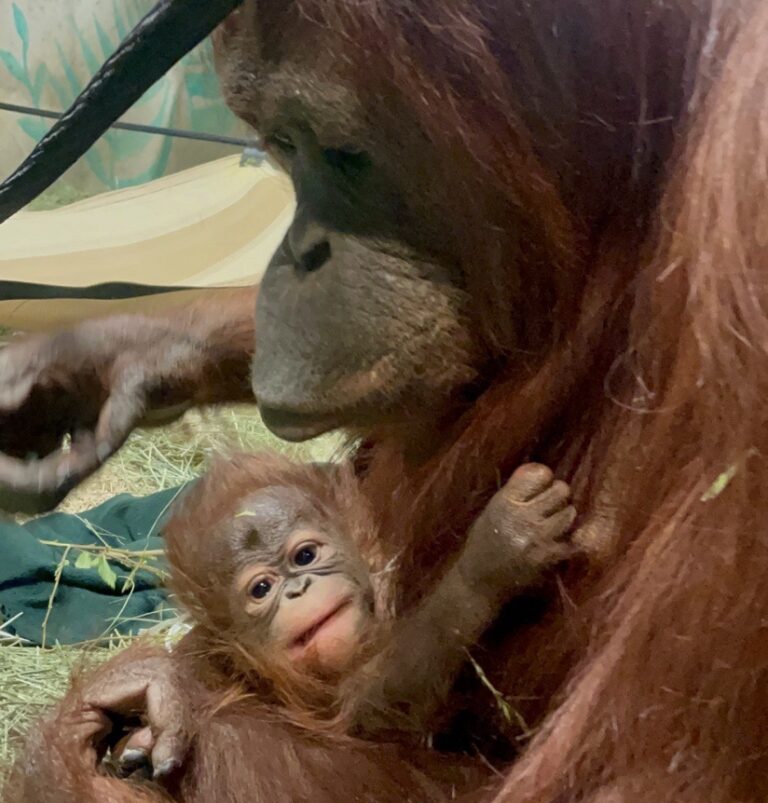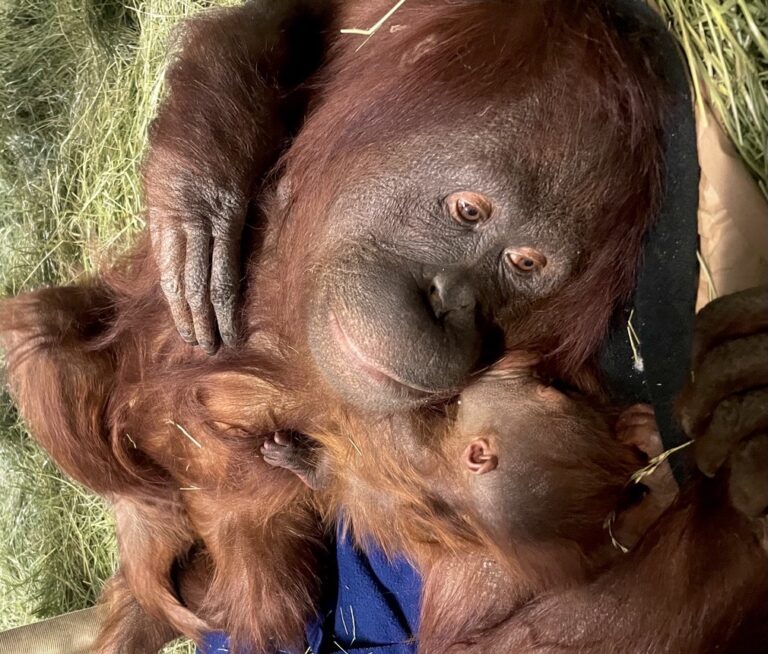

Baby orangutan Weila is introduced to Acara
From hand-rearing to foster care
Since this June, Utah’s Hogle Zoo has been providing hand-rearing care to the littlest red head in Great Apes.
Weila was born to 24-year-old Kawan on June 21, 2025. After the birth, Kawan showed gentle and attentive behavior toward Weila, but nursing did not occur, which is critical within the first 24 hours. Despite positive reinforcement to encourage nursing, it became clear that hand-rearing care was necessary for Weila’s health.
In the weeks that followed, Hogle Zoo’s caregivers provided round-the-clock physical contact and support for Weila. The team wore specialized vests designed to imitate orangutan fur and were trained to mimic orangutan mothering behavior. They carefully tracked feedings and developmental progress.
From the start of the hand-rearing process, the goal was to eventually place Weila with a foster orangutan. It’s important for young orangutans to grow up learning from other orangutans. While the care team was able to provide constant support, prolonged human attachment can make it harder for an infant to join their orangutan family successfully later on.
Foster foundations
To prepare Weila for fostering, caregivers helped her build strength so she could hold on tightly and lift her head to take bottles. At the same time, the animal care team worked with Acara, a female orangutan who had previously fostered her younger brother, Tuah, in 2014, to reinforce her maternal behaviors to prepare her for the possibility of becoming Weila’s caregiver.

Swinging into a new chapter
Two-month-old Weila’s story now continues with a significant new chapter: life with foster orangutan, Acara.
Introductions were gradual and carefully planned. In the weeks leading up, Acara participated in training sessions where she gently interacted with Weila through a mesh barrier. These early sessions went smoothly, with Acara calmly allowing Weila to touch her, mouth her finger, and even tug on her hair.
Because Acara showed positive behaviors, the team shifted its focus to ensuring Weila was ready. Caregivers worked on building her strength so she could hold on tightly to Acara, and teaching her the “bottle” cue, which ensures she can reliably receive her feedings by holding onto the mesh and positioning herself for her bottle when prompted.
On August 19, 2025, the team conducted another protected contact session to confirm that both orangutans were still responding well. Afterwards, Weila was placed in a soft nest of fleece blankets inside the orangutan space, and Acara was given access to her. Keepers remained nearby to encourage Acara’s maternal behaviors and reassure her during moments of uncertainty. Trainers remained on watch throughout the day and overnight, supporting both orangutans as they took this meaningful first step together. Acara’s confidence grew steadily, making the first introduction a success.
With Acara now fostering, fewer people are needed to care for Weila directly. Acara is taking on the role of carrying and comforting her, while the care team focuses on training with Acara to support bottle feedings. This involves teaching Acara to bring Weila to the mesh so she can position herself for her bottle when prompted. The training has been going well, and Weila’s formula intake has stayed within a healthy, normal range.
What comes next for Weila and Acara?
Since this is still a new relationship, the team is taking things day by day. At times, Acara has shown she may want breaks, not because she isn’t interested in Weila, but because she has extra energy and wants to play with Tuah, her brother. The goal is for Acara to provide as much care as she can and wants to, with keepers supporting as needed. This balance may change over time as both Acara and Weila continue to adjust.
Kawan, Weila’s mother, continues to receive attentive care to support her wellbeing. She alternates between habitats with either Mia or Tuah, and all of the orangutans are adjusting well to the current routine.
Weila and Acara are not yet visible to the public. This time behind-the-scenes allows Weila and Acara to bond and work on essential behaviors as they adapt to their new environment. For updates, follow @hoglezoo on Facebook and Instagram.

Animal wellbeing
As a critically endangered species, every orangutan birth is significant. While we were hopeful Kawan would be able to raise her infant, our team was fully prepared for any outcome, including placing Weila with a foster to give her the opportunity to grow up learning from an orangutan. Planning a range of animal needs and providing exceptional maternal and infant care are essential to Hogle Zoo’s commitment to animal wellbeing.
Orangutan conservation
Through our commitment to the AZA Orangutan SSP, we are proud to contribute to this critically endangered species. Bornean orangutan populations have declined by more than 50% in the past 60 years, primarily due to habitat loss. For more than a decade, Hogle Zoo has partnered with the Hutan-Kingabatangan Orangutan Conservation Program to restore vital rainforest habitats.
The palm oil industry is a significant contributor to deforestation in orangutan habitats. The community can download the Palm Oil Scan App to identify which products use sustainable palm oil and make orangutan friendly shopping choices.

